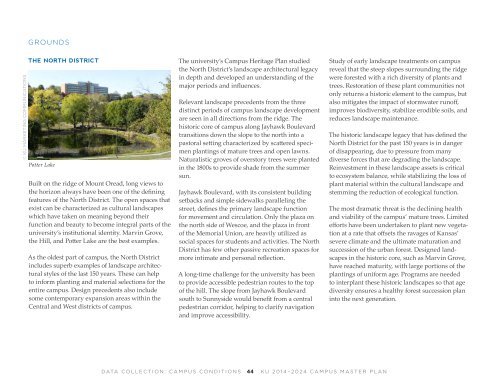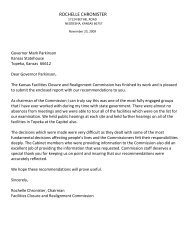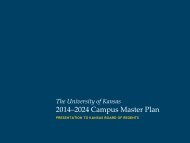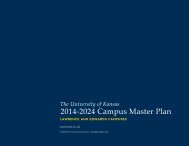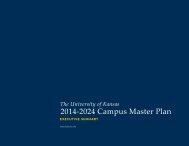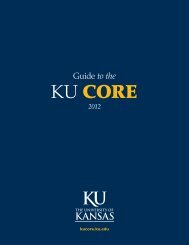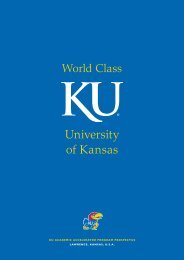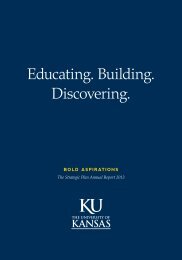KU_Chapter01_DataCollection_2014-06-10
KU_Chapter01_DataCollection_2014-06-10.pdf
KU_Chapter01_DataCollection_2014-06-10.pdf
- No tags were found...
Create successful ePaper yourself
Turn your PDF publications into a flip-book with our unique Google optimized e-Paper software.
GROUNDS<br />
© <strong>KU</strong> MARKETING COMMUNICATIONS<br />
THE NORTH DISTRICT<br />
Potter Lake<br />
Built on the ridge of Mount Oread, long views to<br />
the horizon always have been one of the defining<br />
features of the North District. The open spaces that<br />
exist can be characterized as cultural landscapes<br />
which have taken on meaning beyond their<br />
function and beauty to become integral parts of the<br />
university’s institutional identity. Marvin Grove,<br />
the Hill, and Potter Lake are the best examples.<br />
As the oldest part of campus, the North District<br />
includes superb examples of landscape architectural<br />
styles of the last 150 years. These can help<br />
to inform planting and material selections for the<br />
entire campus. Design precedents also include<br />
some contemporary expansion areas within the<br />
Central and West districts of campus.<br />
The university’s Campus Heritage Plan studied<br />
the North District’s landscape architectural legacy<br />
in depth and developed an understanding of the<br />
major periods and influences.<br />
Relevant landscape precedents from the three<br />
distinct periods of campus landscape development<br />
are seen in all directions from the ridge. The<br />
historic core of campus along Jayhawk Boulevard<br />
transitions down the slope to the north into a<br />
pastoral setting characterized by scattered specimen<br />
plantings of mature trees and open lawns.<br />
Naturalistic groves of overstory trees were planted<br />
in the 1800s to provide shade from the summer<br />
sun.<br />
Jayhawk Boulevard, with its consistent building<br />
setbacks and simple sidewalks paralleling the<br />
street, defines the primary landscape function<br />
for movement and circulation. Only the plaza on<br />
the north side of Wescoe, and the plaza in front<br />
of the Memorial Union, are heavily utilized as<br />
social spaces for students and activities. The North<br />
District has few other passive recreation spaces for<br />
more intimate and personal reflection.<br />
A long-time challenge for the university has been<br />
to provide accessible pedestrian routes to the top<br />
of the hill. The slope from Jayhawk Boulevard<br />
south to Sunnyside would benefit from a central<br />
pedestrian corridor, helping to clarify navigation<br />
and improve accessibility.<br />
Study of early landscape treatments on campus<br />
reveal that the steep slopes surrounding the ridge<br />
were forested with a rich diversity of plants and<br />
trees. Restoration of these plant communities not<br />
only returns a historic element to the campus, but<br />
also mitigates the impact of stormwater runoff,<br />
improves biodiversity, stabilize erodible soils, and<br />
reduces landscape maintenance.<br />
The historic landscape legacy that has defined the<br />
North District for the past 150 years is in danger<br />
of disappearing, due to pressure from many<br />
diverse forces that are degrading the landscape.<br />
Reinvestment in these landscape assets is critical<br />
to ecosystem balance, while stabilizing the loss of<br />
plant material within the cultural landscape and<br />
stemming the reduction of ecological function.<br />
The most dramatic threat is the declining health<br />
and viability of the campus’ mature trees. Limited<br />
efforts have been undertaken to plant new vegetation<br />
at a rate that offsets the ravages of Kansas’<br />
severe climate and the ultimate maturation and<br />
succession of the urban forest. Designed landscapes<br />
in the historic core, such as Marvin Grove,<br />
have reached maturity, with large portions of the<br />
plantings of uniform age. Programs are needed<br />
to interplant these historic landscapes so that age<br />
diversity ensures a healthy forest succession plan<br />
into the next generation.<br />
DATA COLLECTION: CAMPUS CONDITIONS<br />
44<br />
<strong>KU</strong> <strong>2014</strong>–2024 CAMPUS MASTER PLAN


